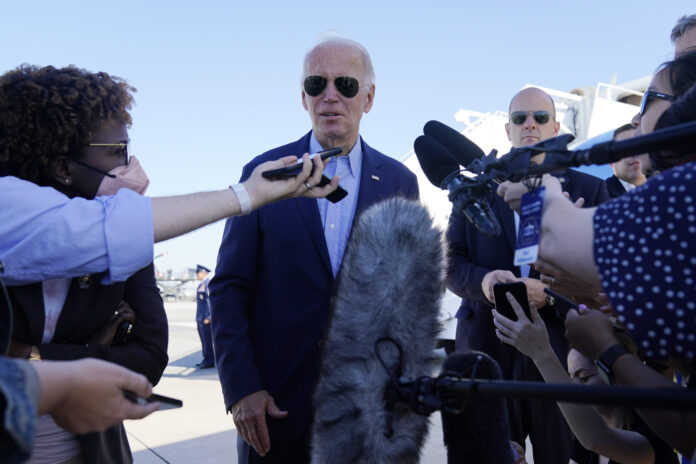President Joe Biden and first lady Jill Biden arrived in Kentucky on Monday to meet with families and view damage from storms that have resulted in the worst flooding in Kentucky’s history.
At least 37 people have died since last month’s deluge, which dropped eight to 10 1/2 inches of rain in only 48 hours. The National Weather Service said Sunday that flooding remains a threat, warning of more thunderstorms through Thursday.
The Bidens will be joined by Gov. Andy Beshear and his wife, Britainy, for a briefing on the flooding’s impact with first responders and recovery specialists at Marie Roberts Elementary School in Lost Creek. They will then tour a hard-hit community in the state and meet directly with those affected.
“They will receive an update on the disaster response, thank those on the front lines and share in the community’s grief,” said White House press secretary Karine Jean-Pierre.
Monday’s visit is Biden’s second to the state since taking office last year. He previously visited in December after tornadoes whipped through Kentucky, killing 77 people and leaving a trail of destruction.
“I wish I could tell you why we keep getting hit here in Kentucky,” Beshear said recently. “I wish I could tell you why areas where people may not have much continue to get hit and lose everything. I can’t give you the why, but I know what we do in response to it. And the answer is everything we can. These are our people. Let’s make sure we help them out.”
Biden has expanded federal disaster assistance to Kentucky, ensuring the federal government will cover the full cost of debris removal and other emergency measures.
Trending Stories
Heat warning extended for large swaths of eastern and western Canada
Air Canada rejects passenger compensation claims, citing staff shortages and safety
Jean-Pierre said the Federal Emergency Management Agency has provided more than $3.1 million in relief funds, and hundreds of rescue personnel have been deployed to help.
Kentucky flooding: 3 still missing, no new deaths as hundreds remain homeless
“The floods in Kentucky and extreme weather all around the country are yet another reminder of the intensifying and accelerating impacts of climate change and the urgent need to invest in making our communities more resilient to it,” she said.
The flooding came just one month after Beshear visited Mayfield to celebrate the completion of the first houses to be fully constructed since a tornado nearly wiped out the town. Three families were handed keys to their new homes that day, and the governor in his remarks hearkened back to a visit he had made in the immediate aftermath.
“I pledged on that day that while we had been knocked down, we were not knocked out,” Beshear said. “That we would get back up again and we would move forward. And six months to the day, we’re not just up, we’re not just standing on our feet, we are moving forward.”
Now more disasters are testing the state. Beshear has been to eastern Kentucky as many times as weather permitted since the flooding began. He’s had daily news conferences stretching an hour to provide details including a full range of assistance for victims. Much like after the tornadoes, Beshear opened relief funds going directly to people in the beleaguered regions.
A Democrat, Beshear narrowly defeated a Republican incumbent in 2019, and he’s seeking a second term in 2023.
Polling has consistently shown him with strong approval ratings from Kentuckians. But several prominent Republicans have entered the governor’s race, taking turns pounding the governor for his aggressive pandemic response and trying to tie him to Biden and rising inflation.
Beshear comments frequently about the toll surging inflation is taking in eating at Kentuckians’ budgets. He avoids blaming Biden, instead pointing to the Russian invasion of Ukraine and supply chain bottlenecks as contributors to rising consumer costs.
© 2022 The Canadian Press



